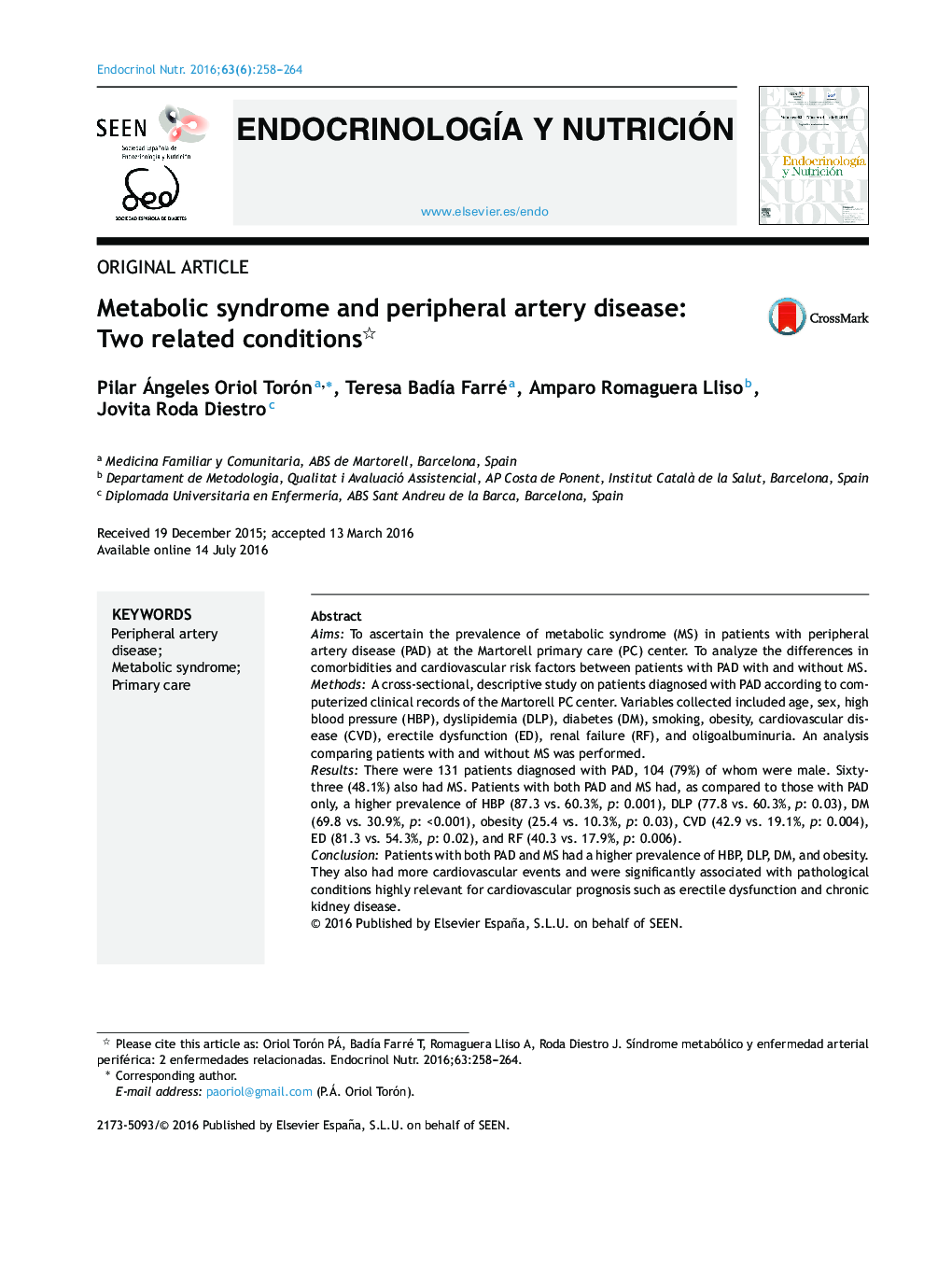| Article ID | Journal | Published Year | Pages | File Type |
|---|---|---|---|---|
| 3266793 | Endocrinología y Nutrición (English Edition) | 2016 | 7 Pages |
AimsTo ascertain the prevalence of metabolic syndrome (MS) in patients with peripheral artery disease (PAD) at the Martorell primary care (PC) center. To analyze the differences in comorbidities and cardiovascular risk factors between patients with PAD with and without MS.MethodsA cross-sectional, descriptive study on patients diagnosed with PAD according to computerized clinical records of the Martorell PC center. Variables collected included age, sex, high blood pressure (HBP), dyslipidemia (DLP), diabetes (DM), smoking, obesity, cardiovascular disease (CVD), erectile dysfunction (ED), renal failure (RF), and oligoalbuminuria. An analysis comparing patients with and without MS was performed.ResultsThere were 131 patients diagnosed with PAD, 104 (79%) of whom were male. Sixty-three (48.1%) also had MS. Patients with both PAD and MS had, as compared to those with PAD only, a higher prevalence of HBP (87.3 vs. 60.3%, p: 0.001), DLP (77.8 vs. 60.3%, p: 0.03), DM (69.8 vs. 30.9%, p: <0.001), obesity (25.4 vs. 10.3%, p: 0.03), CVD (42.9 vs. 19.1%, p: 0.004), ED (81.3 vs. 54.3%, p: 0.02), and RF (40.3 vs. 17.9%, p: 0.006).ConclusionPatients with both PAD and MS had a higher prevalence of HBP, DLP, DM, and obesity. They also had more cardiovascular events and were significantly associated with pathological conditions highly relevant for cardiovascular prognosis such as erectile dysfunction and chronic kidney disease.
ResumenObjetivosConocer la prevalencia de síndrome metabólico (SM) en pacientes afectos de enfermedad arterial periférica (EAP) en el centro de Atención Primaria (AP) de Martorell. Analizar las diferencias de comorbilidad y factores de riesgo cardiovascular asociados (FRCV) en pacientes con EAP según presenten o no SM.MetodologíaEstudio descriptivo transversal. Sujetos: pacientes diagnosticados de EAP según historia clínica informatizada de AP de Martorell. Mediciones: edad, sexo, hipertensión arterial (HTA), dislipidemia (DLP), diabetes (DM), tabaquismo, obesidad, enfermedad cardiovascular (ECV), disfunción eréctil (DE), insuficiencia renal (IR) y oligoalbuminuria. Análisis: frecuencias para variables discretas, medias y desviación típica (DS) para las variables continuas. Se realizó análisis bivariante que comparaba pacientes que presentaban EAP y SM con los que solo presentaban EAP.ResultadosUn total de 131 pacientes diagnosticados de EAP, 104 (79%) varones. De ellos, 63 (48,1%) presentaron SM, de los que 46 (73%) eran varones. Los pacientes que combinaban EAP y SM, en comparación con los que solo tenían EAP, presentaban mayor prevalencia de HTA (87,3 vs. 60,3%; p: 0,001), DLP (77,8 vs. 60,3%; p: 0,03), DM (69,8 vs. 30,9%; p < 0,001), obesidad (25,4 vs. 10,3%; p: 0,03), ECV (42,9 vs. 19,1%; p: 0,004), DE (81,3 vs. 54,3%; p: 0,02) e IR (40,3 vs. 17,9%; p: 0,006).ConclusionesLos pacientes que combinan EAP y SM presentan una mayor prevalencia de HTA, DLP, DM y obesidad; padecen más eventos cardiovasculares a nivel cardiaco o cerebral, y se asocian, también de manera significativa a entidades patológicas tan relevantes desde el punto de vista del pronóstico cardiovascular como la DE y la enfermedad renal crónica.
